4 常用时态一览表 附例句
四大时态
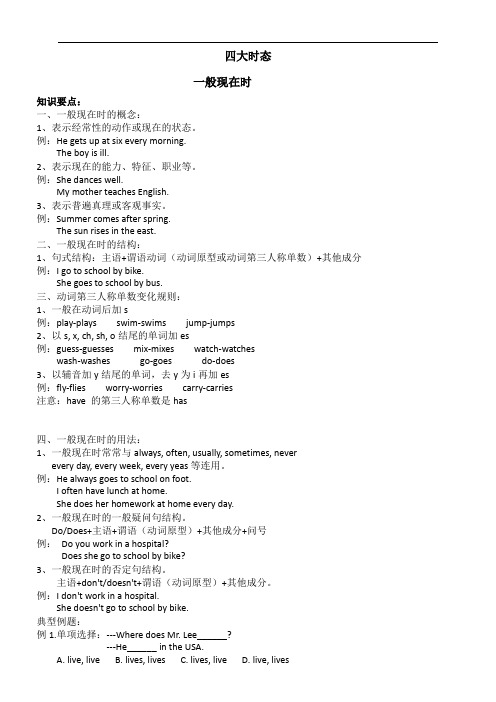
四大时态一般现在时知识要点:一、一般现在时的概念:1、表示经常性的动作或现在的状态。
例:He gets up at six every morning.The boy is ill.2、表示现在的能力、特征、职业等。
例:She dances well.My mother teaches English.3、表示普遍真理或客观事实。
例:Summer comes after spring.The sun rises in the east.二、一般现在时的结构:1、句式结构:主语+谓语动词(动词原型或动词第三人称单数)+其他成分例:I go to school by bike.She goes to school by bus.三、动词第三人称单数变化规则:1、一般在动词后加s例:play-plays swim-swims jump-jumps2、以s, x, ch, sh, o结尾的单词加es例:guess-guesses mix-mixes watch-watcheswash-washes go-goes do-does3、以辅音加y结尾的单词,去y为i再加es例:fly-flies worry-worries carry-carries注意:have 的第三人称单数是has四、一般现在时的用法:1、一般现在时常常与always, often, usually, sometimes, neverevery day, every week, every yeas等连用。
例:He always goes to school on foot.I often have lunch at home.She does her homework at home every day.2、一般现在时的一般疑问句结构。
Do/Does+主语+谓语(动词原型)+其他成分+问号例:Do you work in a hospital?Does she go to school by bike?3、一般现在时的否定句结构。
英语的四大时态用法及结构
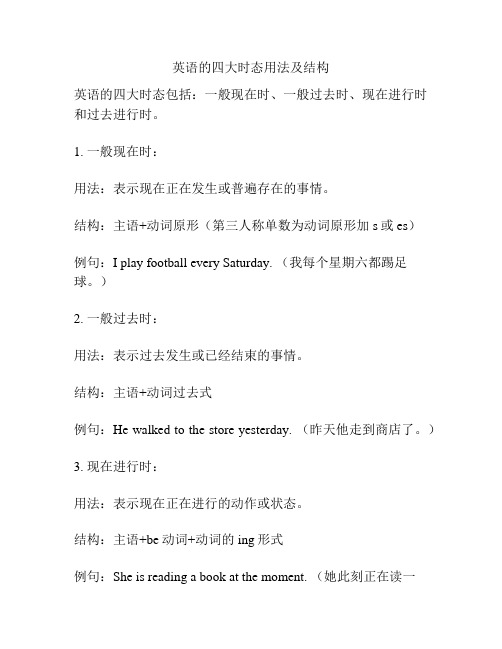
英语的四大时态用法及结构
英语的四大时态包括:一般现在时、一般过去时、现在进行时和过去进行时。
1. 一般现在时:
用法:表示现在正在发生或普遍存在的事情。
结构:主语+动词原形(第三人称单数为动词原形加s或es)
例句:I play football every Saturday. (我每个星期六都踢足球。
)
2. 一般过去时:
用法:表示过去发生或已经结束的事情。
结构:主语+动词过去式
例句:He walked to the store yesterday. (昨天他走到商店了。
)
3. 现在进行时:
用法:表示现在正在进行的动作或状态。
结构:主语+be动词+动词的ing形式
例句:She is reading a book at the moment. (她此刻正在读一
本书。
)
4. 过去进行时:
用法:表示过去某一时刻正在进行的动作。
结构:主语+was/were+动词的ing形式
例句:They were watching TV when I arrived. (我到达时他们正在看电视。
)。
初中英语动词时态分类及例句
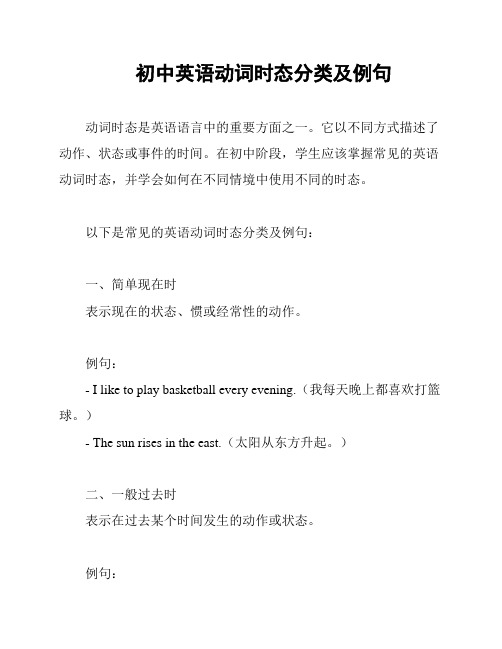
初中英语动词时态分类及例句动词时态是英语语言中的重要方面之一。
它以不同方式描述了动作、状态或事件的时间。
在初中阶段,学生应该掌握常见的英语动词时态,并学会如何在不同情境中使用不同的时态。
以下是常见的英语动词时态分类及例句:一、简单现在时表示现在的状态、惯或经常性的动作。
例句:- I like to play basketball every evening.(我每天晚上都喜欢打篮球。
)- The sun rises in the east.(太阳从东方升起。
)二、一般过去时表示在过去某个时间发生的动作或状态。
例句:- He walked to school yesterday.(昨天他步行去学校了。
)- I visited my grandparents last summer.(我去年夏天拜访了我的祖父母。
)三、现在进行时表示现在正在进行的动作。
例句:- They are watching a movie now.(他们现在正在看电影。
)- She is studying in the library at the moment.(她现在正在图书馆研究。
)四、过去进行时表示过去某个时间正在进行的动作。
例句:- She was teaching in the classroom at 2 pm yesterday.(昨天下午2点她正在教室里上课。
)- I was studying when he called me.(他给我打电话的时候我正在研究。
)五、将来时表示将要发生的动作或状态。
例句:- They will go to Beijing next week.(他们下周将去北京。
)- I am sure she will like the present.(我确信她会喜欢这个礼物。
)六、过去完成时表示过去某个时间之前已经完成的动作。
例句:- She had finished her work by 5 pm.(下午5点她已经完成了她的工作。
英文表格中短语的时态
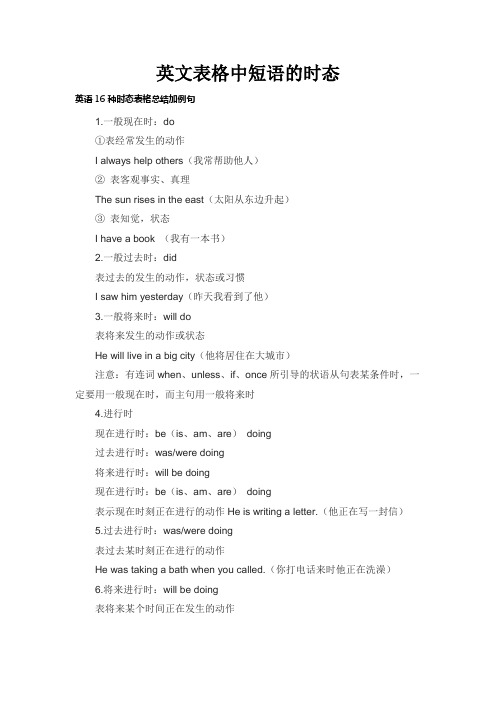
英文表格中短语的时态英语16种时态表格总结加例句1.一般现在时:do①表经常发生的动作I always help others(我常帮助他人)②表客观事实、真理The sun rises in the east(太阳从东边升起)③表知觉,状态I have a book (我有一本书)2.一般过去时:did表过去的发生的动作,状态或习惯I saw him yesterday(昨天我看到了他)3.一般将来时:will do表将来发生的动作或状态He will live in a big city(他将居住在大城市)注意:有连词when、unless、if、once所引导的状语从句表某条件时,一定要用一般现在时,而主句用一般将来时4.进行时现在进行时:be(is、am、are)doing过去进行时:was/were doing将来进行时:will be doing现在进行时:be(is、am、are)doing表示现在时刻正在进行的动作He is writing a letter.(他正在写一封信)5.过去进行时:was/were doing表过去某时刻正在进行的动作He was taking a bath when you called.(你打电话来时他正在洗澡)6.将来进行时:will be doing表将来某个时间正在发生的动作This time next day they will be sitting in the cinema.(明天这个时候他们会坐在电影院里)7.完成时现在完成时:have/has done过去完成时:had done将来完成时:will have done现在完成时:have/has done(过去分词)完成状态:用以表示到现在为止完成的动作(动作不延续,瞬间完成或时间很短)She has already come (她已经来了)未完成状态:用以表示过去某一时间开始到现在为止仍在继续的动作或状态(适用于延续性的动作)She has livedhere for 10 years. (她已经在这里住了10年了),8.过去完成时:had done用以表示截至过去某时为止所完成的动作或状态例1. He had already left when I came.(我来时他已经离开了)注意:过去完成时不能单独存在,要与另一个一般过去时或表过去的副词短语连用,即呈现过去不同时间发生的两个动作,先发生的用过去完成时,后发生的用一般过去时。
英语十六种时态表格(附准确例句)

主语+had+ done
(done指动词汇的往日分词汇)
(例句:Nick had studied English for one year by the end of last month.)
had搁于句尾.
had+ not+ done
2.will/shall+not+ be + doing
7、当前完毕时
往日爆收的然而是对于当前有做用的动做
already, yet, just, ever, recently,in the past few years等,及由for或者since带领的时间状语
主语+have/ has +done
(done指动词汇的往日分词汇)
主语+be动词汇+doing
(doing指动词汇的当前分词汇)
(例句:Nick is studying English now.)
把be动词汇搁正在句尾.
主语+am/ is/ are +not +doing
5、往日举止时
表示往日某一时刻正正在举止的动做
at this time yesterday,
或者以when带领的状语从句(谓语动词汇是普遍往日时)
主语+had+been+doing
(例句:Nick had been studying English by the end of last month.)
把had搁正在句尾.
Had + not + been + doing
12、将去完毕举止时
(完整版)英语十六种时态表格(附准确例句)
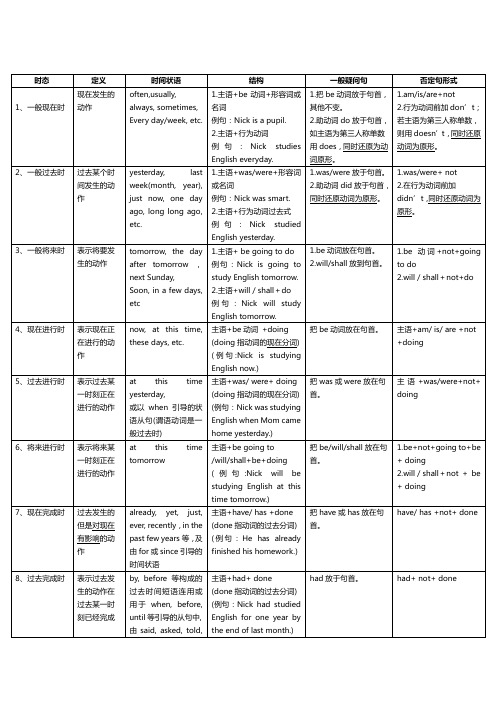
1.be动词放在句首。2.will/shall放到句首。
1.be动词+not+going to do
2.will/shall+not+do
4、现在进行时
表示现在正在进行的动作
now, at this time, these days, etc.
(例句:He has already finished his homework.)
把have或has放在句首。
have/ has +not+ done
8、过去完成时
表示过去发生的动作在过去某一时刻已经完成
by, before等构成的过去时间短语连用或用于when, before, until等引导的从句中,
2.will/shall+not + be + doing
7、现在完成时
过去发生的但是对现在有影响的动作
already, yet, just, ever, recently,in the past few years等,及由for或since引导的时间状语
主语+have/ has +done
(done指动词的过去分词)
主语+had+been+doing
(例句:Nick had been studying English by the end of last month.)
把had放在句首。
Had + not + been + doing
12、将来完成进行时
过去发生的动作,在将来的某个时刻持续进行并产生影响
For...by the end of
小学英语常见四种时态及其区别(附例句)
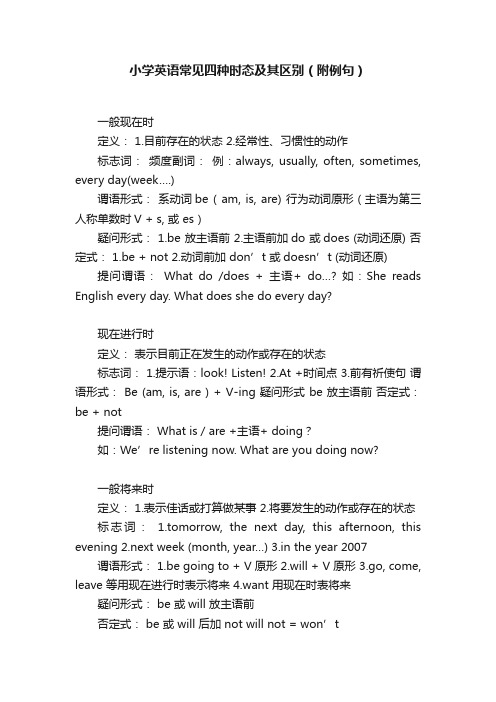
小学英语常见四种时态及其区别(附例句)一般现在时定义: 1.目前存在的状态 2.经常性、习惯性的动作标志词:频度副词:例:always, usually, often, sometimes, every day(week….)谓语形式:系动词be ( am, is, are) 行为动词原形(主语为第三人称单数时V + s, 或 es)疑问形式: 1.be 放主语前 2.主语前加do 或does (动词还原) 否定式: 1.be + not 2.动词前加don’t 或doesn’t (动词还原) 提问谓语:What do /does + 主语+ do…? 如:She reads English every day. What does she do every day?现在进行时定义:表示目前正在发生的动作或存在的状态标志词: 1.提示语:look! Listen! 2.At +时间点 3.前有祈使句谓语形式: Be (am, is, are ) + V-ing 疑问形式 be 放主语前否定式:be + not提问谓语: What is / are +主语+ doing?如:We’re listening now. What are you doing now?一般将来时定义: 1.表示佳话或打算做某事 2.将要发生的动作或存在的状态标志词: 1.tomorrow, the next day, this afternoon, this evening 2.next week (month, year…) 3.in the year 2007 谓语形式: 1.be going to + V 原形 2.will + V 原形 3.go, come, leave 等用现在进行时表示将来 4.want 用现在时表将来疑问形式: be 或will 放主语前否定式: be 或 will 后加not will not = won’t提问谓语:1.What is/ are +…going to do…? 2.What will + 主语+do…? 如:He will play basketball next week. What will he do next week?一般过去式定义:表示过去时间内发生的动作或存在的状态标志词:1.yesterday, last week/ year/ month 等 2.two years ago/ in 2005 / at that time谓语形式: 1.动词be 的过去时(was, were) 2.行为动词的过去式疑问形式: 1.was / were 放主语前 2.主语前加did (动词还原) 否定式: 1.was/ were + not 2.动词前加didn’t (动词还原) 提问谓语: What did + 主语+ do…?如:Tom did his homework last night. What did Tom do last night?一般过去时 eg:He went to library.现在进行时 eg:He is going to library.一般现在时 eg:He goes to library.一般将来时 eg:He will go to library. eg:He is going to take the exams.*现在完成时 eg:He has been in china for five years. eg:He has been in china since five years ago. eg:I have gone to china.1.现在一般时与现在完成时1) I come from Shanghai(上海人)I have come from Shanghai(从上海来)2) You read very well. (强调能力)You've read very well. (强调一次刚完成的动作)3) I forget.(一时想不起来了)I have forgotten.(仍没想起来,可能已回忆起来了)4) The book is written in simple English. (表状态)The book has been written in simple English.(表动态,已用英语写成)5) Every time I see him, he's been reading. (两个动作不可能同时进行) Every time I have seen him, he's been reading. (强调两个动作同时进行)6) He is gone. (强调状态)He has gone (强调动作和时间)7) He won't come till the play begins. (演出开始时) He won't come till the play has begun.(戏已开始)8) After I leave school, I'll go to college. (两个动作紧密相接)After I have left school, I'll go to college.(强调毕业后,两个动作可能有间隔)9) It is a long time since I saw you last. It's been a long time since I saw you last.(这两句话一样,后一句是美国英语)10) Where are you (在哪)Where have you been(去了哪)2. 现在一般时与现在进行时1) He works hard.(强调始终如一)He is working hard.(强调现在)2) What do you do (干什么工作的)What are you doing(在干什么)3) Here comes the bus! (表高兴和欣慰)The bus is coming.(汽车到来的情景)4) I forget him name. I'm forgetting his name.(差点把他的名字忘了)5) You don't eat much. (强调胃口不大)You're not eating much.(你怎么不吃呀)6) The match starts at 7 o'clock. (比较固定,不宜改变) The match is starting at 7 o'clock.(可以改变)7) Tom always comes late. Tom is always coming late.(表示不满,责备)8)Tom goes to college now.Tom is going to college now.(这两句区别不大,后者更生动)9) I tell you.(我可以告诉你)I'm telling you.(我告诉你吧,有感情色彩)10) He always sleeps in the afternoon.He is always sleeping in the afternoon.(后者意味着整个下午都睡掉了)11) I expect you to phone me. ( 几乎等于命令) I'm expecting you to phone me.(婉转)12) What do you say What are you saying(你说些什么呀,表说话人惊讶,不满)13) I find that the book is too difficult for me.(强调结果) I'm finding that the book is too difficult for me. (强调过程,逐渐感到)14) Apples cost more these days.(强调事实)Apples are costing more these days.(越来越贵) 14) He always thinks of others.He's always thinking of others.(表示赞扬)15) Whenever I see him, he argues with somebody.(强调两个动作有先后) Whenever I see him, he is arguing with somebody.(强调两个动作同时进行)16) I hope you'll give us some advice.I'm hoping you'll give us some advice.(表示语气婉转)17) I must go. (我应该去)I must be going.(我该走了)18) We can discuss this while we eat.(说话是没用餐)We can discuss this while we are eating.(进餐已开始)3. 现在完成时与过去一般时1) I've seen him this morning.(还在上午的时间里) I saw him this morning.(时间已不在上午了)2) Who's opened the window (窗户还在开着)Who opened the window (与现在无关,窗户可能已关上)3) Have you ever heard him sing (他可能不是爱唱歌)Did you ever hear him sing(你曾听过他唱歌吗,他可能是歌唱家) 4) Have you ever heard of such a thing (你听过这种事吗)Did you ever hear of such a thing(这种事, 你听说过吗是一个修辞性问题,表示惊异。
一般现在时、现在进行时、一般将来时、一般过去时四大时态讲解表格对比总结
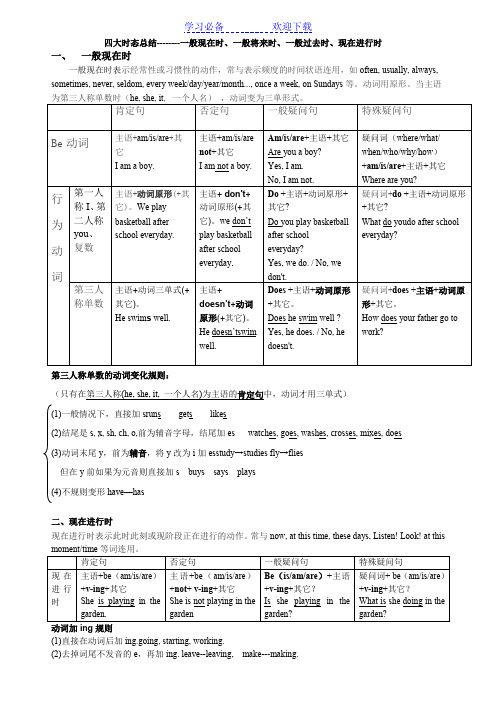
四大时态总结--------一般现在时、一般将来时、一般过去时、现在进行时一、一般现在时一般现在时表示经常性或习惯性的动作,常与表示频度的时间状语连用,如often, usually, always, sometimes, never, seldom, every week/day/year/month..., once a week, on Sundays等。
动词用原形。
当主语第三人称单数的动词变化规则:(只有在第三人称(he, she, it, 一个人名)为主语的肯定句中,动词才用三单式)(1)一般情况下,直接加sruns gets likes(2)结尾是s, x, sh, ch, o,前为辅音字母,结尾加es watches, goes, washes, crosses, mixes, does(3)动词末尾y,前为辅音,将y改为i加esstudy→studies fly→flies但在y前如果为元音则直接加s buys says plays(4)不规则变形have—has二、现在进行时现在进行时表示此时此刻或现阶段正在进行的动作。
常与now, at this time, these days, Listen! Look! at this动词加ing规则(1)直接在动词后加ing.going, starting, working.(2)去掉词尾不发音的e,再加ing. leave--leaving, make---making.注意:如果单词结尾的e发音,则不能去掉,也直接加ing. see –seeingagree - agreeing .(3) 对于动词只有一个元音,而其后跟了一个辅音字母时,双写末尾辅音字母再加ing.sitting, beginningrun – runningstop – stoppingcut – cuttingcontrol – controlling(4)以ie结尾,把ie变y再加ing。
英语时态大全(16种)及例句展示

英语时态大全(16种)在汉语中,表示时态的语法并不多,没有那么强调时态,而英语则不同,在时态上的语法表达极为讲究,今天就来讲一讲英语的所有时态语法以及例句展示。
(过去)1、一般过去时(did)2、过去进行时(was/were doing)3、过去完成时(had done)4、过去完成进行时(had been doing )(现在)5、一般现在时(do/does)6、现在进行时(am/is/are doing)7、现在完成时(has/have done)8、现在完成进行时(has/have been doing)(将来)9、一般将来时(will/shall do)10、将来进行时(will/shall be doing)11、将来完成时(will/shall have done )12、现在完成进行时(will/shall have been doing)(过去将来)13、一般过去将来时(would/should do)14、过去将来进行时(would/should be doing)15、过去将来完成时(would/should have done)16、过去将来完成进行时(would/should have been doing)时间轴例句:1、I ate lunch我吃了午餐2、I was doing my homework yesterday in this time昨天这个时候我正在做作业3、I had done my homework since yesterday我昨天完成了作业4、I had been learning English for three hours我已经学了三个小时的英语5、I want to eat lunch我想去吃午饭6、I am drinking water我正在喝水7、I have played football for two hours我已经踢了两小时足球8、I have been watching TV for an hour我已经看了一个小时电视了9、I will learn swim next week下周我将要去学习游泳10、I will be learning swim tomorrow in this time 明天这个时候我要去学游泳11、I will have been married for 2 years by then.到那时我已经结婚两年了12、I will have been having a holiday by May 2021到2021年5月,我将度过一个假期13、He asked me yesterday when I should leave for Shanghai昨天他问我什么时候动身去上海14、He said he would be looking after your mother他说他会照顾你妈妈的15、He said he should have got on the bus by then.他说那时他已经上了公交了。
(完整版)小学英语四大时态表格版
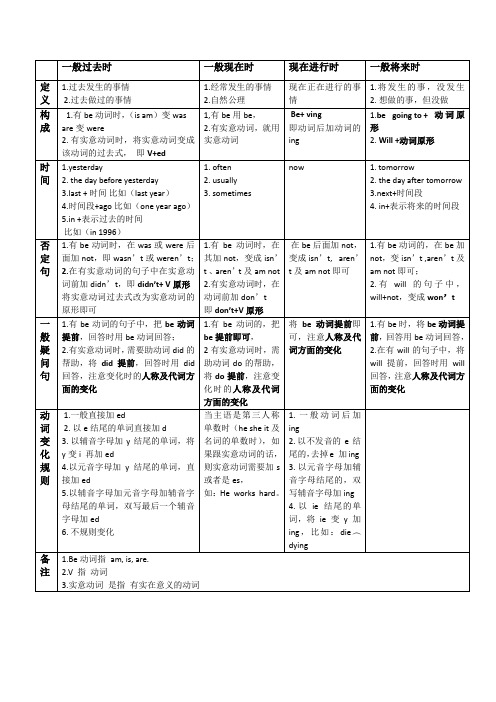
备注
1.Be动词指am, is, are.
2.V指动词
3.实意动词是指有实在意义的动词
5.以辅音字母加元音字母加辅音字母结尾的单词,双写最后一个辅音字母加ed
6.不规则变化
当主语是第三人称单数时(he she it及名词的单数时),如果跟实意动词的话,则实意动词需要加s或者是es,
如:He workshard。
1.一般动词后加ing
2.以不发音的e结尾的,去掉e加ing
3.以元音字母加辅音字母结尾的,双写辅音字母加ing
比如(in ly
3.sometimes
now
1.tomorrow
2.the day after tomorrow
3.next+时间段
4.in+表示将来的时间段
否定句
1.有be动词时,在was或were后面加not,即wasn’t或weren’t;
2.在有实意动词的句子中在实意动词前加didn’t,即didn’t+ V原形
一般过去时
一般现在时
现在进行时
一般将来时
定义
1.过去发生的事情
2.过去做过的事情
1.经常发生的事情
2.自然公理
现在正在进行的事情
1.将发生的事,没发生2.想做的事,但没做
构成
1.有be动词时,(isam)变was
are变were
2.有实意动词时,将实意动词变成该动词的过去式,即V+ed
1,有be用be,
2.有实意动词,就用实意动词
Be+ ving
即动词后加动词的ing
1.begoing to+动词原形
英语时态总结表格16种

英语时态总结表格16种时态在英语语言中非常重要,它能帮助我们准确地表达事件的发生时间。
在英语中,我们有许多不同的时态来表示过去、现在和将来的事件。
在本文中,我将为大家总结英语的16种时态,并提供每一种时态的用法和例句。
1. 现在简单时态 (Present Simple)用法:描述常规的行为、事实或普遍真理。
例句:I play football every weekend.2. 过去简单时态 (Past Simple)用法:描述发生在过去某个具体时间的行为或事实。
例句:She traveled to Europe last year.3. 将来简单时态 (Future Simple)用法:描述将来的行为或计划。
例句:They will arrive at the airport tomorrow.4. 现在进行时态 (Present Continuous)用法:描述现在正在发生的动作。
例句:He is studying for his exams at the moment.5. 过去进行时态 (Past Continuous)用法:描述过去某一特定时间正在进行的动作。
例句:They were playing football when it started raining.6. 将来进行时态 (Future Continuous)用法:描述将来某一时间正在进行的动作。
例句:I will be studying at the library tomorrow afternoon.7. 现在完成时态 (Present Perfect)用法:描述过去发生但与现在有联系的动作或经历。
例句:She has visited Paris many times.8. 过去完成时态 (Past Perfect)用法:描述过去某一时间或事件之前发生的动作。
例句:They had already eaten dinner when we arrived.9. 将来完成时态 (Future Perfect)用法:描述将来某一时间之前已经完成的动作。
4种时态(一般现在时,一般过去时,一般将来时,现在进行时)的时间状语及用法
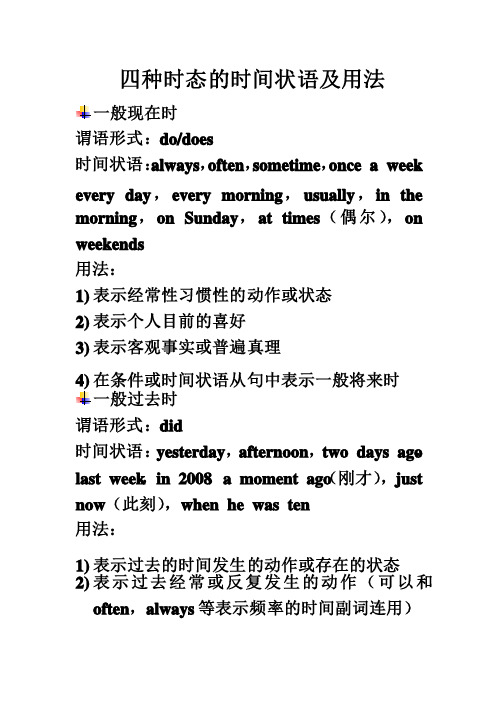
四种时态的时间状语及用法一般现在时谓语形式:do/does时间状语:always,often,sometime,once a week,every day,every morning,usually,in the morning,on Sunday,at times(偶尔),on weekends用法:1)表示经常性习惯性的动作或状态2)表示个人目前的喜好3)表示客观事实或普遍真理4)在条件或时间状语从句中表示一般将来时一般过去时谓语形式:did时间状语:yesterday,afternoon,two days ago,last week,in 2008,a moment ago(刚才),just now(此刻),when he was ten用法:1)表示过去的时间发生的动作或存在的状态2)表示过去经常或反复发生的动作(可以和often,always等表示频率的时间副词连用)一般将来时谓语形式:will/shall+do/be going to do 时间状语:next week,this Sunday,next time tomorrow,the day after tomorrow(明后两天),from now on(从今以后),in a minute,some day 用法: 1)表示将来的时间要发生的动作或存在的状态2)表示将来经常或反复发生的动作3)表示打算;计划;决定要做某事现在进行时谓语形式:am/is/are+doing 时间状语:now,these days(这几天)用法:1)表示现在(说话瞬间)正在进行或发生的动作2)表示当前一段时间内的活动或现阶段正在进行的动作。
各种时态的英语表达

各种时态的英语表达英语时态是一种表达动作或状态在时间上的方式。
英语时态包括现在时、过去时、将来时和过去将来时。
1. 现在时:英语表达:动词原形或第三人称单数形式。
例子:I eat an apple every day. (我每天吃一个苹果。
)2. 过去时:英语表达:动词的过去式。
例子:She worked hard yesterday. (她昨天工作很努力。
)3. 将来时:英语表达:情态动词“will”加动词原形或“be going to”加动词原形。
例子:He will come to see me tomorrow. (他明天会来看我。
)4. 过去将来时:英语表达:情态动词“would”加动词原形或“was/were going to”加动词原形。
例子:He said he would come to my party. (他说他会来参加我的聚会。
)以上是各种时态的英语表达和例子,希望对你有帮助。
5. 现在完成时:英语表达:have/has + 过去分词。
例子:I have finished my homework. (我已经完成了我的作业。
)6. 过去完成时:英语表达:had + 过去分词。
例子:She had eaten the cake before he came. (他在来之前已经吃了蛋糕。
)7. 将来完成时:英语表达:will + have + 过去分词。
例子:They will have finished their work by tomorrow. (他们将在明天之前完成他们的工作。
)8. 过去将来完成时:英语表达:would + have + 过去分词。
例子:He said he would have finished his work by then. (他说他将在那时之前完成他的工作。
)。
英语四大时态结构_含例句
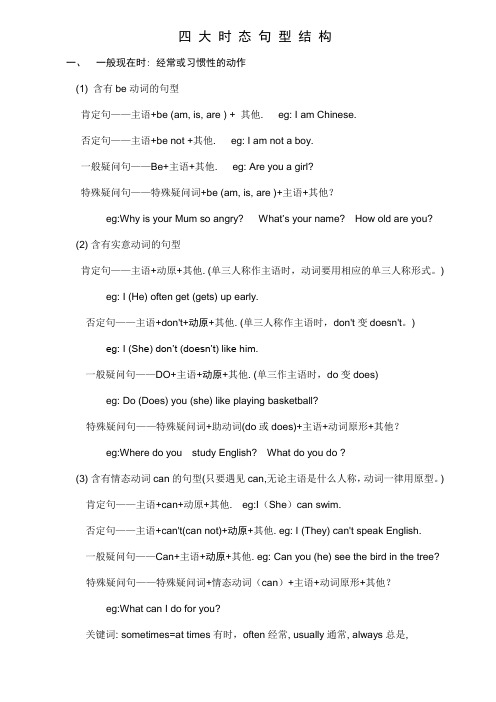
四大时态句型结构一、一般现在时: 经常或习惯性的动作(1) 含有be动词的句型肯定句——主语+be (am, is, are ) + 其他. eg: I am Chinese.否定句——主语+be not +其他. eg: I am not a boy.一般疑问句——Be+主语+其他. eg: Are you a girl?特殊疑问句——特殊疑问词+be (am, is, are )+主语+其他?eg:Why is your Mum so angry? What’s your name? How old are you? (2) 含有实意动词的句型肯定句——主语+动原+其他. (单三人称作主语时,动词要用相应的单三人称形式。
) eg: I (He) often get (gets) up early.否定句——主语+don't+动原+其他. (单三人称作主语时,don't变doesn't。
) eg: I (She) don’t (doesn’t) like him.一般疑问句——DO+主语+动原+其他. (单三作主语时,do变does)eg: Do (Does) you (she) like playing basketball?特殊疑问句——特殊疑问词+助动词(do或does)+主语+动词原形+其他?eg:Where do you study English? What do you do ?(3) 含有情态动词can的句型(只要遇见can,无论主语是什么人称,动词一律用原型。
)肯定句——主语+can+动原+其他. eg:I(She)can swim.否定句——主语+can't(can not)+动原+其他. eg: I (They) can't speak English.一般疑问句——Can+主语+动原+其他. eg: Can you (he) see the bird in the tree?特殊疑问句——特殊疑问词+情态动词(can)+主语+动词原形+其他?eg:What can I do for you?关键词: sometimes=at times有时,often经常, usually通常, always总是,every day每天, on Sunday afternoon在周日下午, five days a week一周五天, three times a month一个月三次…二、现在进行时: 正在发生的动作或存在的状态肯定句——主语+be+动词的现在分词(ing)+其他. eg: I am reading now.否定句——主语+be not+动词的现在分词(ing)+其他. eg: I am not working.一般疑问句——Be +主语+动词的现在分词(ing)+其他? eg: Are you sleeping?特殊疑问句——特殊疑问词+ be +主语+动词的现在分词(ing)+其他?eg:What are you doing?关键词:now现在, at the moment此刻, look, listen, keep quiet等提示语.三、一般将来时: 将要发生的动作(1)含有will的句型肯定句——主语+will+动词原型+其他. eg: I will call you later.否定句——主语+will not +动词原型+其他. eg: I will not go to the park.一般疑问句——Will +主语+动词原型+其他. Will you go shopping with her?特殊疑问句——特殊疑问词+will +主语+动词原形+其它?(will 可改为be going to ,疑问句中当主语是第一人称时will改为shall)(2)含有be going to 的句型肯定句——主语+be(am / is / are) + going to +动词原形+其它.否定句——主语+be(am / is / are)+not + going to +动词原形+其它.一般疑问句——Be(am / is / are) +主语+ going to +动词原形+其它?特殊疑问句——特殊疑问词+ be(am / is / are) +主语+ going to +动词原形+其它?关键词:tomorrow, next year明年, tonight今晚, this year今年, at the end of this term这学期期末, from now on从现在开始, soon一会儿马上, later后稍后,in three days三天之内, in the future未来…四、一般过去时: 过去发生的动作强调时间(1)含有be动词的句型肯定句——主语+be(was,were)+其他. eg: I was born on July.1st, 2000.否定句——主语+be(was,were) not+其他. eg: I was not born in 1999.一般疑问句—Be(was,were)+主语+其他? eg: Were you born in January?特殊疑问句—特殊疑问词+ be(was,were)+主语+其他. eg: When was he born?(2)含有实意动词过去式的句型肯定句——主语+动词的过去式+其他. eg: Lily went shopping yesterday.否定句——主语+did not+动原+其他. eg: He did not go to school today.一般疑问句——Did+主语+动原+其他? eg:Did she pass the test?特殊疑问句—特殊疑问词+did+主语+动原+其他. eg:Where did you go yesterday?关键词:yesterday昨天,last week上周, last year去年, 一段时间+ago如ten years ago十年前five hours ago五小时前, in +年/月,on+具体日期...Just now=a moment ago刚才,in the old days从前, long ago很久以前...。
英语十个时态造句
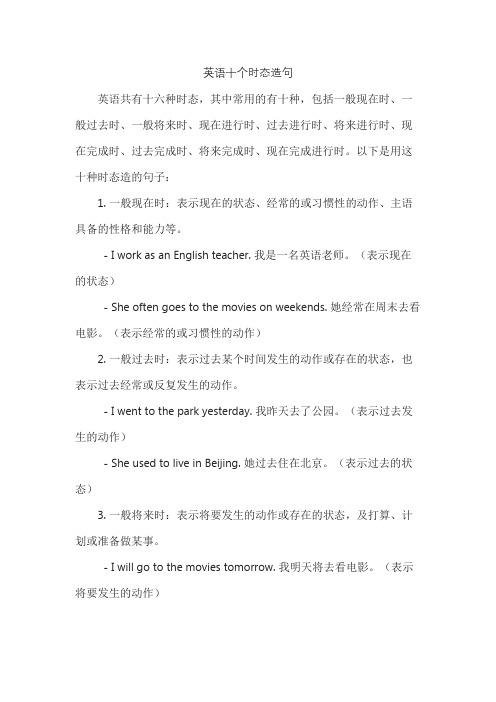
英语十个时态造句英语共有十六种时态,其中常用的有十种,包括一般现在时、一般过去时、一般将来时、现在进行时、过去进行时、将来进行时、现在完成时、过去完成时、将来完成时、现在完成进行时。
以下是用这十种时态造的句子:1. 一般现在时:表示现在的状态、经常的或习惯性的动作、主语具备的性格和能力等。
- I work as an English teacher. 我是一名英语老师。
(表示现在的状态)- She often goes to the movies on weekends. 她经常在周末去看电影。
(表示经常的或习惯性的动作)2. 一般过去时:表示过去某个时间发生的动作或存在的状态,也表示过去经常或反复发生的动作。
- I went to the park yesterday. 我昨天去了公园。
(表示过去发生的动作)- She used to live in Beijing. 她过去住在北京。
(表示过去的状态)3. 一般将来时:表示将要发生的动作或存在的状态,及打算、计划或准备做某事。
- I will go to the movies tomorrow. 我明天将去看电影。
(表示将要发生的动作)- She is going to study abroad next year. 她明年打算出国留学。
(表示打算、计划做某事)4. 现在进行时:表示现在正在进行或发生的动作,或当前一段时间内的活动或现阶段正在进行的动作。
- I am watching TV now. 我现在正在看电视。
(表示现在正在进行的动作)- She is studying English this year. 她今年正在学习英语。
(表示现阶段正在进行的动作)5. 过去进行时:表示过去某段时间或某一时刻正在发生或进行的动作。
- I was watching TV at 8 last night. 昨晚八点我正在看电视。
(表示过去某一时刻正在进行的动作)- She was studying English when I called her. 我给她打电话时,她正在学习英语。
英语的几种时态结构及例句

英语的几种时态结构及例句全文共四篇示例,供读者参考第一篇示例:英语中有多种时态结构,每种时态都有其特定的用法和含义。
掌握这些时态结构对于学习英语的人来说是非常重要的。
在本文中,我们将介绍几种常见的英语时态结构以及例句。
1. 现在时态(Simple Present Tense):现在时态表示当前正在发生的动作或状态。
它用于表达日常习惯、自然定律、常规真理等。
例句:He plays basketball every Sunday.(他每个星期天都打篮球。
)2. 过去时态(Simple Past Tense):过去时态用于描述已经发生的动作或状态。
它通常和具体的过去时间一起使用。
例句:She studied English last night.(她昨晚学习英语。
)5. 过去进行时态(Past Continuous Tense):过去进行时态用于表示过去某一时刻正在进行的动作。
它由was/were + 动词-ing构成。
例句:They were watching TV when I called them.(当我打电话给他们时,他们正在看电视。
)以上是关于英语的几种时态结构及例句。
通过学习和掌握这些时态,可以帮助我们准确、流畅地表达自己的思想和情感。
希望这些例句可以帮助你更好地理解和应用英语时态结构。
第二篇示例:英语是一门使用丰富的时态结构的语言。
不同的时态可以表达不同的时间关系和含义。
在英语中,时态结构有多种,包括简单现在时、进行时、完成时、过去将来时等。
在本文中,我们将逐一介绍这些时态结构,并给出一些例句来帮助读者更好地理解它们。
1. 简单现在时(Simple Present)简单现在时通常用来表达习惯、常态、真理等情况。
它的基本结构是主语+ 动词原形。
例句:- I go to school every day.- She speaks English fluently.- Dogs bark loudly at night.2. 进行时(Present Continuous)进行时用来表示现在正在进行的动作或临时状态。
英语时态总结(完整)
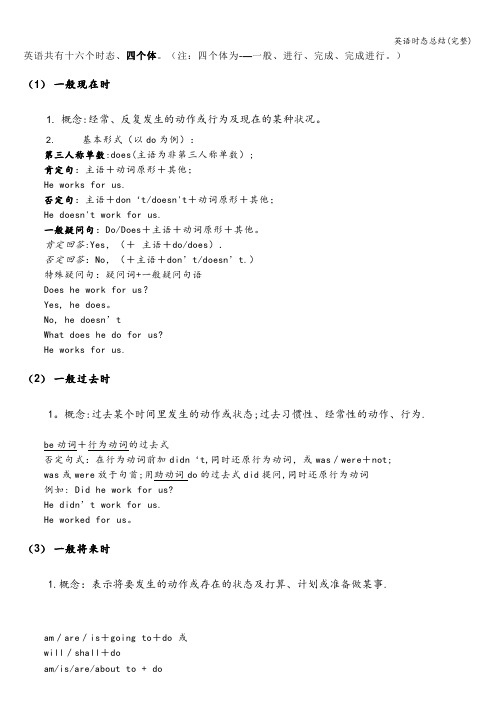
英语共有十六个时态、四个体。
(注:四个体为-—一般、进行、完成、完成进行。
)(1)一般现在时1. 概念:经常、反复发生的动作或行为及现在的某种状况。
2. 基本形式(以do为例):第三人称单数:does(主语为非第三人称单数);肯定句:主语+动词原形+其他;He works for us.否定句:主语+don‘t/doesn't+动词原形+其他;He doesn't work for us.一般疑问句:Do/Does+主语+动词原形+其他。
肯定回答:Yes,(+主语+do/does).否定回答:No,(+主语+don’t/doesn’t.)特殊疑问句:疑问词+一般疑问句语Does he work for us?Yes, he does。
No, he doesn’tWhat does he do for us?He works for us.(2)一般过去时1。
概念:过去某个时间里发生的动作或状态;过去习惯性、经常性的动作、行为.be动词+行为动词的过去式否定句式:在行为动词前加didn‘t,同时还原行为动词,或was/were+not;was或were放于句首;用助动词do的过去式did提问,同时还原行为动词例如: Did he work for us?He didn’t work for us.He worked for us。
(3)一般将来时1.概念:表示将要发生的动作或存在的状态及打算、计划或准备做某事.am/are/is+going to+do 或will/shall+doam/is/are/about to + doam/is/are to + do;一般将来时的表达方法be going to +动词原形be +不定式,be to+动词原形,be about to +动词原形be able to +不定式be about to+动词原形will + 动词原形;例如:He is going to work for us.He will work for us;He is coming.这是特殊的用一般现在时表达将来时态的例子!!(4)过去将来时概念:立足于过去某一时刻,从过去看将来,常用于宾语从句中。
四种时态的句子(英语)
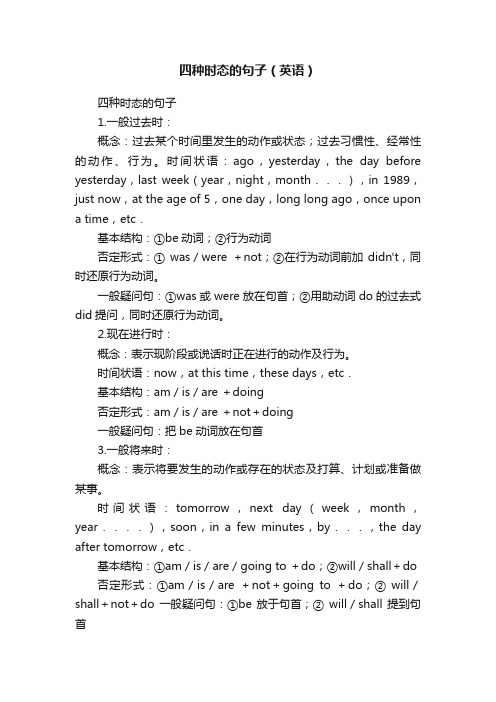
四种时态的句子(英语)四种时态的句子1.一般过去时:概念:过去某个时间里发生的动作或状态;过去习惯性、经常性的动作、行为。
时间状语:ago,yesterday,the day before yesterday,last week(year,night,month...),in 1989,just now,at the age of 5,one day,long long ago,once upon a time,etc.基本结构:①be动词;②行为动词否定形式:① was/were +not;②在行为动词前加didn't,同时还原行为动词。
一般疑问句:①was或were放在句首;②用助动词do的过去式did提问,同时还原行为动词。
2.现在进行时:概念:表示现阶段或说话时正在进行的动作及行为。
时间状语:now,at this time,these days,etc.基本结构:am/is/are +doing否定形式:am/is/are +not+doing一般疑问句:把be动词放在句首3.一般将来时:概念:表示将要发生的动作或存在的状态及打算、计划或准备做某事。
时间状语:tomorrow,next day(week,month,year....),soon,in a few minutes,by...,the day after tomorrow,etc.基本结构:①am/is/are/going to +do;②will/shall+do 否定形式:①am/is/are +not+going to +do;② will/shall+not+do 一般疑问句:①be放于句首;② will/shall提到句首4.一般现在时:概念:经常、反复发生的动作或行为及现在的某种状况。
时间状语:often,usually,always,sometimes,every week (day,year,month...),once a week,on Sundays,etc.基本结构:①be动词;②行为动词否定形式:① am /is /are +not;②此时态的谓语动词若为行为动词,则在其前加don't,如主语为第三人称单数,则用doesn't,同时还原行为动词。
英语四种时态的例句
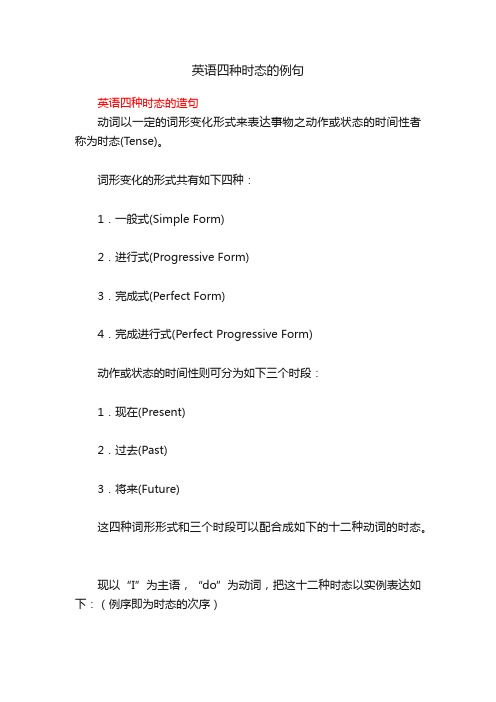
英语四种时态的例句英语四种时态的造句动词以一定的词形变化形式来表达事物之动作或状态的时间性者称为时态(Tense)。
词形变化的形式共有如下四种:1.一般式(Simple Form)2.进行式(Progressive Form)3.完成式(Perfect Form)4.完成进行式(Perfect Progressive Form)动作或状态的时间性则可分为如下三个时段:1.现在(Present)2.过去(Past)3.将来(Future)这四种词形形式和三个时段可以配合成如下的十二种动词的时态。
现以“I”为主语,“do”为动词,把这十二种时态以实例表达如下:(例序即为时态的次序)1.I do it every day. (1. 一般现在时)(我每天做这样的事。
)2.I did it yesterday. (2. 一般过去时)(昨天我做了这件事。
)3.I shall/will do it tomorrow.(3. 一般将来时)(明天我要做这件事。
)4.I am doing it now. (4. 现在进行时)(现在我正在做这件事。
)5.I was doing it at that time. (5. 过去进行时)(当时我正在做这件事。
)6.I shall/will be doing it at 9:00 tomorrow morning. (6. 将来进行时)(明天早晨九时我会正在做这件事。
)7.I have done it already. (7. 现在完成时)(我已把这件事做好了。
)8.I had done it before I went home yesterday. (8. 过去完成时)(昨天我在回家之前就把那件工作做完了。
)9.I shall/will have done it before you come back tomorrow.(9. 将来完成时)(明天在我回来之前我会把这件工作做好。
- 1、下载文档前请自行甄别文档内容的完整性,平台不提供额外的编辑、内容补充、找答案等附加服务。
- 2、"仅部分预览"的文档,不可在线预览部分如存在完整性等问题,可反馈申请退款(可完整预览的文档不适用该条件!)。
- 3、如文档侵犯您的权益,请联系客服反馈,我们会尽快为您处理(人工客服工作时间:9:00-18:30)。
1、一般现在时
The present simple tense
do
does
am, is, are
2、一般过去时
The simple past tense
did
was
were
Idomy homework everyday.
Hedoeshis homework everyday.
haddone
Ihavealreadyseenthe film.
Hehasalreadyseenthat film.
By the time I went outside, the bus hadalreadyleft.
When I got to school, I realized Ihad leftmy backpack at home.
1)在现在某一时刻或某段时间里正在进行的动作。
2)按计划安排在现在的将来发生的动作。
1)在过去的某一时刻或某段时间里正在进行的动作。
2)按计划安排在过去的将来发生的动作。
5、现在完成时
The present perfect tense
has
done
have
→
6、过去完成时
The past perfect tense
been done
have
→
6、过去完成时
hadbeen done
The boyhas been madeto work long.
那男孩已经被迫工作很长时间了。
Shehas madethe boy work long.(主动)
Hehad been operatedon twice since then.
shall
do
will
→
8、过去将来时
Thepastfuturetense
should
do
would
Ishall/willgo to the park tomorrow.
Iam going tothe park tomorrow.
He said hewould cometo see me.
She said shewas going tostart at once.
Theydotheir homework everyday.
Iama student.
Heisa student.
Theyarestudents.
Ididmy homeworkyesterday.
Hedidhis homework yesterday.
Theydidtheir homework yesterday.
Iwasa student ten years ago.
Hewasa student ten years ago.
Theywerestudents ten years ago.
1)现在惯性的动作或存在的状态。
2)客观事实,真理或格言。
3)表示现在将来时。(只用于时间状语或条件状语从句中)
1)过去习惯性的的动作或存在的状态。
1)动作发生在过去,对目前有影响。
(注:瞬间性动词的已完成用法)
2)动作发生在过去,一直延续到现在,对目前有影响。
(注:延续性动词的已完成或未完成用法)
1)过去有两个动作,其中,一个动作发生时,另一个动作已经完成。(注:过去的过去,用过去完成时)
7、一般将来时
The future simple tense
他昨天上午十点正在种一棵树。
Hewas plantinga tree at 10:00yesterday.(主动)
1)在现在某一时刻或某段时间里正在进行的动作。
2)按计划安排在现在的将来发生的动作。
1)在过去的某一时刻或某段时间里正在进行的动作。
2)按计划安排在过去的将来发生的动作。
5、现在完成时
has
自那以来他做了两次手术。
Theyhad operatedon him twice since then.(主动)
2)用于“were-型”和“if-型”虚拟语气中。
3)表示过去将来时。(只用于时间状语或条件状语从句中)
3、现在进行时
The present continuous tense
am
isdoing
are
4、过去进行时
The past continuous tense
was
doing
were
Iam doingmy homework now.
was
done
were
My caris parkednear our house.
我的车停在我家附近。
Iparkmy car near our house.(主动)
The was paintedwhite.
墙被漆成了白色。
Hepaintedthe wall white.(主动)
1)现在惯性的动作或存在的状态。
2)客观事实,真理或格言。
3)表示现在将来时。(只用于时间状语或条件状语从句中)
1)过去习惯性的的动作或存在的状态。
2)用于“were-型”和“if-型”虚拟语气中。
3)表示过去将来时。(只用于时间状语或条件状语从句中)
3、现在进行时
am
isbeing done
are
4、过去进行时
was
being done
1)在现在的将来发生的动作。
(注:含现在将来的意愿、预见或意图)
1)在过去的将来发生的动作。
(注:含过去将来的意愿、预见或意图)
备注:doing=动词的现在分词(-ing分词)done=动词的过去分词(-ed分词)
英语被动语态的名称、用法及谓语一览表
1、一般现在时
am
is done
are
2、一般过去时
were
The childis being takengood care of.
Good careis being takenof the child.
那孩子正在受到精心照料。
Theyare takinggood care of the child.(主动)
A treewas being plantedby himat 10:00 yesterday.
Heis doinghis homework now.
Theyare doingtheir homework now.
Iwas doingmy homeworkwhen the phone rang.
Hewas doinghis homeworkwhen the phone rang.
Theywere doinghis homework when the phone rang.
